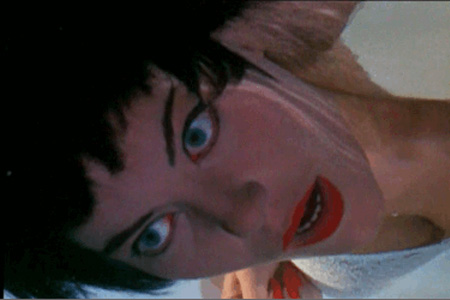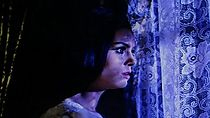There is something to be said for the idea that the modern horror movie began with Mario Bava. Or, to be more specific, there is something to be said for the idea that modern horror movie began with the late Italian genre master’s visually lush 1963 feature, Blood and Black Lace. It was an international hit that’s become one of the most imitated films in history—albeit often unknowingly, by filmmakers who’ve probably never heard of it. As for another Bava feature from 1963, The Whip and the Flesh: No one was quite ready for the horror-tinged, perverse Gothic melodrama a half-century ago, and it’s still pretty eye-opening stuff today.
Bava’s first release in that very busy year, Evil Eye, aka The Girl Who Knew Too Much, is sometimes considered the first giallo—an Italian term for pulp fiction that was eventually applied to myriad violent European horror thriller. But it’s actually more of a Hitchcockian exercise in rollercoaster peril a la North by Northwest. Blood and Black Lace is the real deal, an endlessly stylish elaboration of a threadbare murder-mystery script into a series of baroque, fetishistic, sadistic setpieces. While Halloween would be widely credited as starting the whole “slasher” subgenre 15 years later, its seeds were laid in this equally virtuoso triumph of style over content. It created the blueprint for horror films entirely built around the stalking and killing of pretty (mostly female) youth by faceless assailants.
Bava primarily uses suggestion rather than gore to make us squirm, and the beautifully atmospheric preludes to each demise milk the maximum out of what’s not there: Protagonists wander cluttered interiors or shadowy exteriors that are invariably lit with an arresting, color-rich moodiness that would be absurd in real life.
All too conveniently, Black Lace takes place in a milieu where looks are everything—the fashion design house of Christian haute couture, imperiously ruled by Contessa Cristina Como (Hungarian-born Eva Bartok, a popular European leading lady who was about to abandon her career for spiritual pursuits). When one of her models is strangled on the concern’s palatial estate grounds, she leaves behind a diary whose lurid revelations—of cocaine use, infidelity, homosexuality and so forth—many people would prefer remain secret. Thus nearly everyone’s a suspect when the diary goes missing and those who might possess it turn up murdered in ever-more grotesque ways.
Nearly all the victims are beautiful women, most given plenty of opportunity to run around terrified before they are offed by means including a metal claw from a metal suit of armor and a red-hot radiator pressed to an unfortunate face. Yet Bava primarily uses suggestion rather than gore to make us squirm, and the beautifully atmospheric preludes to each demise milk the maximum out of what’s not there: Protagonists wander cluttered interiors or shadowy exteriors that are invariably lit with an arresting, color-rich moodiness that would be absurd in real life.
Why, the over-logical viewer might ask, is an antiques warehouse’s darkness riddled with arbitrary patches of hot pink or pulsating aquamarine light from no apparent source? Because their disorienting effect adds to the suspenseful ambiance, that’s why. Plus: It’s really, really pretty. (Bava’s closest stylistic inheritor, Dario Argento, would take gaudy color-as-atmospheric-end-in-itself even further in his cult favorites Suspiria and Inferno.) The defunct Eastmancolor process seldom looked more eye-poppingly vivid—or, at times, subtle—than amidst Blood’s inexpensive yet infinitely resourceful riots of set decoration and key lighting. (Legend has it the budget was so tight that the film’s graceful tracking shots were accomplished, of necessity, by mounting the camera on a children’s toy wagon.)
Blood and Black Lace was a great success around the world, albeit under numerous different titles and with numerous censors’ cuts in various territories. A very different fate met The Whip and the Flesh—the bafflement and discomfort it generated are exemplified by the fact that it was (barely) released in the U.S. as What!?
What, indeed. Perhaps inspired by Roger Corman’s decorous, vaguely kinky Edgar Allan Poe adaptations of the same era, although venturing much further into territory the Marquis de Sade might have approved, it’s a supernatural costumer set in the requisite gloomy 19th-century seaside castle.
The defunct Eastmancolor process seldom looked more eye-poppingly vivid—or, at times, subtle—than amidst ‘Blood and Black Lace’s’ inexpensive yet infinitely resourceful riots of set decoration and key lighting.
Its inhabitants appear fairly angst-y even before they really get something to wring hands over: The return of prodigal son Kurt (Christopher Lee), who fled in disgrace years earlier over various nefarious deeds including causing the suicide of a servant girl he’d despoiled. In the interim “good” brother Christian (Tony Kendall) has become the principal heir—Kurt having been disowned by their father—and he’s married the bad boy’s former fiancee, Nevenka (Israeli bombshell Daliah Lavi, a ’60s sexpot who arrived with the decade and pretty much vanished with it too).
No one is happy about Kurt’s arrival, though it must be said that Nevenka’s emotions are…mixed. Cornering her on the beach after she’s gone horse riding, he grabs her whip and applies several lusty backside lashes—to her evident enjoyment, after which the mutually aroused duo make love (offscreen, that is). Once night falls, however, someone plunges a dagger into Kurt’s back. That doesn’t end the upheavals, however, violent and/or erotic—it seems even death can’t stop Kurt from wreaking vengeance on his family or threatening Nevenka with more “punishment” that hurts so good.
The S&M element was pretty outre at the time—this morbid love story suffered cuts in most territories where it was released. It was also frequently given senseless alternative titles (like Night Is the Phantom, Son of Satan, even Dracula, The Vampire—the latter because actor Lee played that bloodsucker for Hammer Studios) to make it look like a more conventional horror opus. Seen today, The Whip is still a bit shocking in its blatant if non-explicit sexual twistedness. Its overreliance on false scares can get a bit silly, but Bava’s command of richly evocative color and composition is perfectly suited to this period Gothic context.
Such imagistic extravagance seemed part of his DNA. Born in Northern Italy and originally trained as a painter, Bava instead chose to adopt his father’s cinematography career, working professionally as early as 1939 in his mid-20s. His fine arts background served him well in bringing visual luster and imagination to routine projects, though it wasn’t until 1960 that he was finally allowed to direct a feature of his own. The resulting Black Sunday was a low-budget B&W horror about a reincarnated witch that made an international star out of striking British actress Barbara Steele.
One area in which he could always be counted on to excel, however, was horror. No matter how contrived or senseless the script, his efforts there were always full of arrestingly baroque setpieces.
Its success insured he only work in color from that point onward (with the exception of the aforementioned Evil Eye), invariably elevating highly variable material by use of a refined painter’s eye. When given free rein, he could carve an aesthetic jewel from any genre: 1961’s “muscleman” fantasia Hercules in the Haunted World and 1968’s pop-art spy spoof Danger: Diabolik are classics of their type. (Such films also benefited from his innovative ease creating special optical FX.) But there was little he could do for the mediocre westerns he was assigned, let alone dumb sex comedies like Dr. Goldfoot and the Girl Bombs or Four Times that Night.
One area in which he could always be counted on to excel, however, was horror. No matter how contrived or senseless the script, his efforts there were always full of arrestingly baroque setpieces. Peak achievements are 1963’s omnibus feature Black Sabbath, with its hair-raising segment starring Boris Karloff as a deathless “wurdalak;” 1965’s gorgeous exercise in sci-fi terror Planet of the Vampires; and the next year’s Kill Baby, Kill, an incongruously named 18th-century haunting story with one of cinema’s first evil-little-ghoul-girls as central menace.
Bava’s final films were beset with problems. His least characteristic project, Rabid Dogs (1974), a joltingly realistic, brutal crime drama, lost funding during post-production and was stuck in legal limbo for decades. (It can now be seen in two versions—avoid the one called Kidnapped, which includes an ill-fitting new score and awkward new sequences.) The same year’s Lisa and the Devil was a sumptuous supernatural tale starring Eurobabe Elke Sommer and TV’s “Kojak” Telly Savalas—but to cash in on the Exorcist craze, its producers shot cheesy additional sequences without Bava’s consent or involvement, cut his original footage to shreds, and released the resulting mess worldwide as House of Exorcism. (Fortunately his intended version has since been restored.) He returned to form with 1977’s Shock, even if that film was released in the U.S. as Beyond the Door II—suggesting it was a sequel to a cheap Exorcist ripoff Bava had nothing to do with.
Already middle-aged when his directing career began, Bava understandably felt he’d logged too many miles in the industry to endure such ill-treatment. He retired the next year, dying of a heart attack at 65 two years after that.
His son and longtime assistant director Lamberto (who co-directed Shock) continued in the family business, almost exclusively working in horror. But even Junior’s finest hour, 1985’s gorily energetic Demons, can’t match dad’s oeuvre for sheer physical beauty in a genre not generally known for the elegance of its aesthetics.





